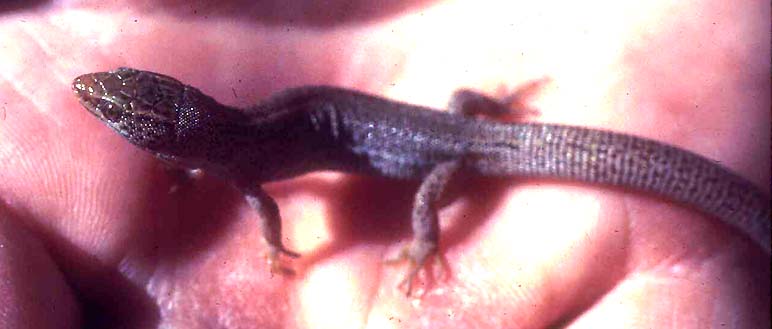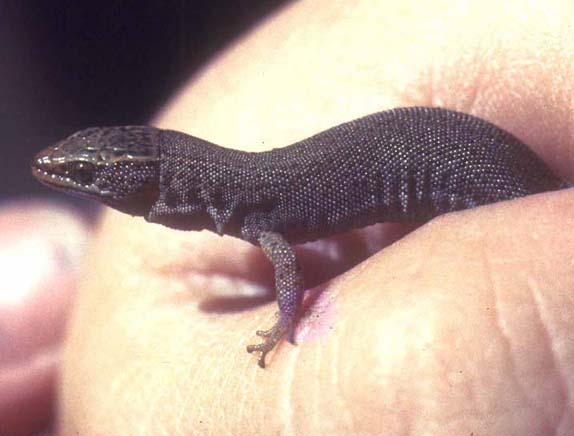 |
 Night
lizards are a small New World family ranging from southwestern U.S. south
to Panama. Most are from Mexico or Central America. Three or four species
(depending on your taxonomy) — all in the genus Xantusia — occur
in California. I've seen two of them but can show you photos of only one:
the Desert Night Lizard X. vigilis (both photos). I was leading
an American Birding Association tour in Joshua Tree Nat'l Monument in April
1978 (before a big ABA Convention) when we stopped to try for this little
guy. We turned over a few old Joshua Tree fronds lying on the ground and...
voila! As you can see, this is a tiny little lizard — barely 3 inches
in total length [this is either my photo and Steve Ballard's hand, or Steve's
photo and my hand.... not sure which]. This dwarf lizard seems to be wearing
a tiny suit of medieval chain-mail. Night
lizards are a small New World family ranging from southwestern U.S. south
to Panama. Most are from Mexico or Central America. Three or four species
(depending on your taxonomy) — all in the genus Xantusia — occur
in California. I've seen two of them but can show you photos of only one:
the Desert Night Lizard X. vigilis (both photos). I was leading
an American Birding Association tour in Joshua Tree Nat'l Monument in April
1978 (before a big ABA Convention) when we stopped to try for this little
guy. We turned over a few old Joshua Tree fronds lying on the ground and...
voila! As you can see, this is a tiny little lizard — barely 3 inches
in total length [this is either my photo and Steve Ballard's hand, or Steve's
photo and my hand.... not sure which]. This dwarf lizard seems to be wearing
a tiny suit of medieval chain-mail.
Desert Night Lizard occurs in a variety of desert and arid habitats throughout southern California and north along the San Joaquin Valley foothills to Pinnacles Nat'l Monument, east side in San Benito Co., and to the Greenhorn Mts. of Kern Co. Unlike many lizards, they bear live young. Despite their name, they are chiefly diurnal or crepuscular but may be nocturnal in the warm summer months. Indeed, it appears that all the night lizards are actually diurnal! Stebbins (2003) says "Because of its secretive habits, this lizard was at one time considered extremely rare, but is now known to be one of the most abundant lizards in the U.S." That's a surprise to me — I haven't encountered one since. Guess I need to look more closely under (to quote Stebbins) "cow chips, soil-matted dead brush ... and beneath logs and under bark of foothill pines." I will admit to having turned very few "cow chips." Dan Singer and I recently looked for Sandstone Night Lizard X. [h.] gracilis in Anza Borrego SP, San Diego Co. It is apparently a recent split from Granite Night Lizard X. [h.] henshawi (together they are known as Henshaw's Night Lizard). Both live in deep crevices in rocky canyons, but the Sandstone — true to its name — occurs in a huge sandstone formation. We looked at night with flashlights, but without success. The final species is the somewhat larger Island Night Lizard X. riversiana of California's Channel Islands. It is known from San Clemente I., San Nicolas I., and Santa Barbara I., plus Sutil Islet. On 17 Oct 1975, I was among a boatload of birders visiting Santa Barbara I. to search for vagrant birds (and quite a few were found), but we also found one of these great little lizards under a sheet of metal lying on the ground. Alas, I didn't take photos. |